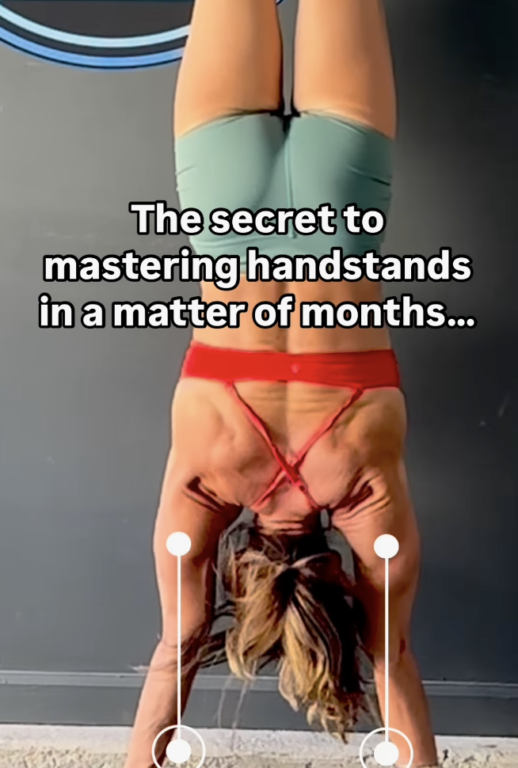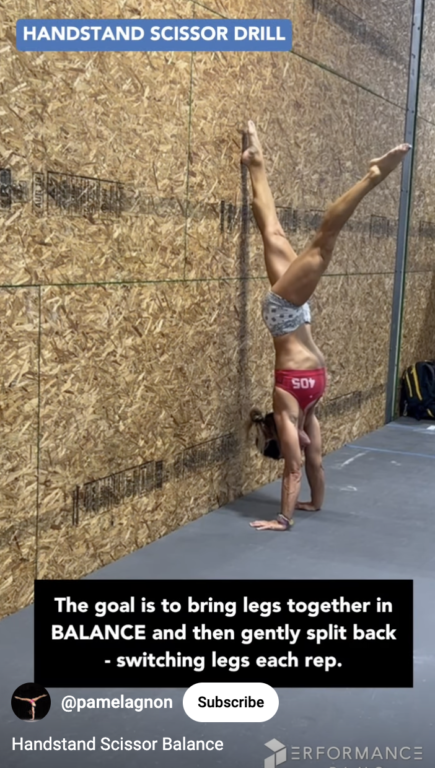This article is the fifth in our series with gymnastics athlete and coach Pamela Gagnon. The first was on kipping pull-ups, the second on toes-to-bar, the third on handstand push-ups, and the fourth on bar muscle-ups. Now, let’s move on to handstand walking.
It may be deemed a party trick, but walking on your hands is a true athletic feat. Besides wanting to be the coolest out of your friend group by kicking up and walking on command, we know the real frustration happens when you see 4 rounds of 50-foot handstand walking in a workout and know you’ll have to resort to bear crawls. Don’t get me wrong, bear crawls are HARD and a great way to build pressing strength inverted, but sometimes we just want to do more gymnastics-style scaling in the workouts.
If your goal is to handstand walk, you need to practice a scale during the workout that is fun, effective, and challenging so you can work toward your goal rather than substitute a filler skill that doesn’t build the strength needed for the full movement.
The Issue
To complete a handstand walk, you need both a solid handstand and the ability to shift weight while inverted. Lacking either makes the movement challenging and intimidating. Building a strong foundation in both will boost your confidence and control.
Let’s Break It Down
Since handstand walking is broken into two parts, the handstand and the weight shifting, let’s understand what you need to master each portion.
 For the handstand, you need more time inverted. The only way to build stability, spatial awareness, and balance is to practice. Through practice, you will be piecing together neurological components of accuracy, agility, balance, and coordination. While practice does not make perfect, it does make you better each day. If you relate this to walking, a baby stands before they walk. If they begin to walk without learning to balance, they fall quickly. The same concept applies to walking on your hands. Not to say you can’t walk on your hands without being good at handstand holds, but you will certainly struggle a lot more.
For the handstand, you need more time inverted. The only way to build stability, spatial awareness, and balance is to practice. Through practice, you will be piecing together neurological components of accuracy, agility, balance, and coordination. While practice does not make perfect, it does make you better each day. If you relate this to walking, a baby stands before they walk. If they begin to walk without learning to balance, they fall quickly. The same concept applies to walking on your hands. Not to say you can’t walk on your hands without being good at handstand holds, but you will certainly struggle a lot more.
For the walking portion of the skill, you need to build the muscles that will support the lean and “press” portion as you lift one hand to step forward. Your upper back muscles, forearms, and shoulders will be taking the brunt of the force. If you understand how to do handstand shrugs, you will truly understand how to “press down” to create tension and momentum versus “lifting” our hands.
THE WORKOUT AND HOW TO SCALE
Workout of the Day
Complete as many rounds as possible in 15 minutes of:
50-foot handstand walk
100-foot walking lunge
THE BEGINNER ATHLETE
Alternate rounds with:
Odd rounds: 5 pike-to-hollow walks
Even rounds: 50-foot overhead plate carry with locked out arms (25/45-lb plate)
The goal is to get inverted while moving through space for the odd rounds and work on tall pressing overhead during the even rounds. The crucial part of training both these skills correctly is keeping the elbows locked out during both skills the entire time. This will ensure you build the muscle memory and strength needed for efficient handstands.
THE INTERMEDIATE ATHLETE
Alternate rounds with:
Odd rounds: 5 wall walks
Even rounds: 25 handstand shrugs (on a box or against the wall)
In the intermediate option, the wall walks require you to shift your weight to the main arm while moving through space, and the handstand shrugs help you build the muscles needed to support your handstand walks.
BUT NOW WHAT?
 You may be an athlete who can wall walk well and handstand shrugs all day long but still can’t handstand walk. What can you do to bridge the gap? The answer is handstand HOLDS. The freestanding handstand hold is the foundation of handstand walking. Let’s face it: kicking up into a handstand without a wall or spotter is very scary. So, you need to build confidence. Preferably, you can work on this skill outside the workout when you can take your time to practice rather than worrying about a clock ticking down.
You may be an athlete who can wall walk well and handstand shrugs all day long but still can’t handstand walk. What can you do to bridge the gap? The answer is handstand HOLDS. The freestanding handstand hold is the foundation of handstand walking. Let’s face it: kicking up into a handstand without a wall or spotter is very scary. So, you need to build confidence. Preferably, you can work on this skill outside the workout when you can take your time to practice rather than worrying about a clock ticking down.
My go-to drill to learn freestanding handstands is the handstand scissor balance drill. The goal is to use the wall for safety while finding that balance as you move your legs from a split position to a stacked position. The split position mimics the kick-up, and the stacked position helps you find balance during inversion while your legs move through space. Try 3-5 sets of practice 3+ days/week. The way to get better at handstands is to be upside down more often. If you work on small sets but more frequently over the month, you will find success without burnout, wrist pain, etc.
Practice
Success in the gymnastics portion of CrossFit requires regular practice, not just attempts during the workout. Therefore, doing drills and warm-ups outside of class will help you feel even more prepared the next time handstand walking appears in the workout.
Do these movements three times a week for the next three weeks.
Day 1
6 rounds, 3 rounds of each skill, 30 seconds work/30 seconds rest:
- Beginner – Alternate between box-pike-to-hollow walks and overhead plate shrugs
- Intermediate – Alternate between penguin walks and handstand scissor balance
Day 2
Accumulate 2 minutes of practice:
- Beginner – Banded I to shrug
- Intermediate – Handstand shoulder taps on a wall or from the box
Day 3
3 rounds, 1 minute of rest between sets
- Beginner – Max effort box-pike-to-hollow walks
- Intermediate – Max handstand scissor balance
Drills and Warm-Ups
A few quality drills and warm-ups include:
- Plank up/downs
- Pike-to-hollow handstand
- Handstand scissor drill
- Handstand shrugs off a box or wall
- Handstand penguin walks
About the Author
 Pamela Gagnon is the co-creator of Performance Plus Programming and the free e-book “5 Key Points to Great Toes To Bar.” She is a four-time Masters CrossFit Games athlete and a former D1 Gymnast. As a CF-L2, she was a lead coach for eight years with the CrossFit Gymnastics Course. She also currently writes gymnastics programming for CrossFit Mayhem.
Pamela Gagnon is the co-creator of Performance Plus Programming and the free e-book “5 Key Points to Great Toes To Bar.” She is a four-time Masters CrossFit Games athlete and a former D1 Gymnast. As a CF-L2, she was a lead coach for eight years with the CrossFit Gymnastics Course. She also currently writes gymnastics programming for CrossFit Mayhem.